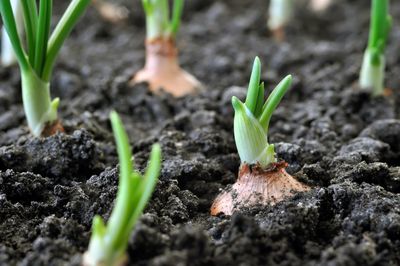Onions are food for the Respiratory System
The Onion is effective against bronchitis and asthma
Onions - Food for the respiratory System
Description of the onion plant: The bulb of the onion plant is not the root of the plant, but rather an underground thickening the stalk. The true roots are formed of filaments on the lower portion of the bulb.
Properties:
No nutrient stands out when one examines the composition of the onion. All vitamins are present (except B12) in small amounts. The same is the case with minerals, among which only potassium is worth mentioning. Among the trace minerals the most abundant is sulfur, which forms part of the onion’s volatile essence.
The onion’s mineral salts are converted to carbonates of alkaline reaction when passed to the blood, which explains the remarkable alkalizing foods facilitate the elimination of waste products from the body, which are all acidic.
In contrast to its rather unimportant nutrient content, the onion is rich in non-nutritive substances of major Physiological activity.
· Essential oil: This oil is responsible for the onion’s typical odor. It is highly volatile and evaporates easily. Its composition is very complex since it is formed from a mixture of more than one hundred different substances, among which allyl disulfide and Thio sulfinate stand out.
· Flavonoids: These glycosides improve blood circulation, prevent blood clots, and block the oxidation of low-density lipoproteins that cause arteriosclerosis. Onions are rich in quercetin, one of the most active flavonoids. A study conducted at the University of Wageningen demonstrates that quercetin is well absorbed in the intestine regardless of whether the onion is raw or cooked. The flavonoids and the substances that form this essential oil are attributed to the onion’s properties: Antibiotic, decongestant, anti-asthmatic, heart and arterial protector, diuretic, and anticarcinogenic.
Onions contain many more non-nutritive substances which are not as well defined as in the two groups above:
· Enzymes: The onion is rich in enzymatic substances such as oxidase and diastase, which have an invigorating effect on digestive processes.
· Glycoquin: Dr. Schneider defines this as a vegetable hormone that reduces the blood glucose level. This explains the onion’s desirable effect on diabetics.
· Vegetable fiber: Fiber contributes to the onion’s lipid-lowering and anti-diabetic action (DELAYS THE PASSAGE OF SUGAR ITO THE BLOOD STREAM.)
Indications for use:
· Respiratory disorders: The sulfur compounds that form the onion’s essential oil pass rapidly to the blood stream from the stomach. They are first released in the lungs. This explains why after only a few minutes of eating onions; the breath has its characteristic odor. Onions can break down heavy mucus and are antibiotic on gram-positive germs.
· Bronchial asthma: The positive effects of onion on the bronchial tubes are felt in only a few minutes after eating them.
· Arteriosclerosis and coronary heart disease:Regular onion consumption in any form prevents Arteriosclerosis, improves blood flow in all the arteries, and reduces the risk of suffering a serious complication such as a heart attack.
· Elevated blood triglycerides: Triglycerides, formed from fatty acids and glycerin, are a type of fat that circulates in the blood. A high triglyceride level promotes arteriosclerosis and heart disease. It has been shown that consuming the liquid extract from onions reduces triglycerides in the blood and liver. Onion also increases HDL (beneficial cholesterol) which helps to prevent arteriosclerosis.
· Kidney disorders: Onion increases urine volume, facilitating the elimination of waste material because of its alkalizing effect. It is appropriate in the diet of those suffering from kidney stones, urinary infections, or any degree of renal failure.
· Diabetes: Onions reduce the blood glucose level. They are indicated for diabetics.
· Liver disorders: Onions stimulate the detoxifying function of the liver as well as improving the activity of other juice producing glands. Highly recommended in cases of hepatic failure caused by chronic hepatitis or cirrhosis.
· Cancer: A study conducted in China, sponsored by the National Cancer Institute of the United States, found that those who eat more onions ad garlic have a much lower risk of the developing stomach cancer. Other studies demonstrate the onion’s capacity, as well as garlic, to prevent the development of major tumor cells and to neutralize carcinogens. {Source of above information: Encyclopedia of Foods Vol. 2)
Preparation and Use
· Raw: This is the best way to eat onions, but for this, they must be fresh. The piquancy is diminished somewhat by washing them for a few minutes and adding lemon. Those suffering from gastric ulcer or gastritis should eat onions either boiled or baked.
· Boiled in Water: Their piquancy disappears, and they are better tolerated but their medicinal effects are also diminished. Cooking time should be short, less than a minute, and the resulting broth should be used as well.
· Baked: Baked onions are very tasty; although the longer they are I the oven, the less effective they are as medicine.
· Onion syrup: Boil several slices of onion. After mashing them to a paste, add a few spoons of honey or brown sugar.
· Onion Water: This is prepared by soaking a chopped raw onion in a glass of water for several hours.
Make sure to add them to your soups, salads and oven meals!

HIS CURE.COM SEEKING GOD'S HEALING HAND